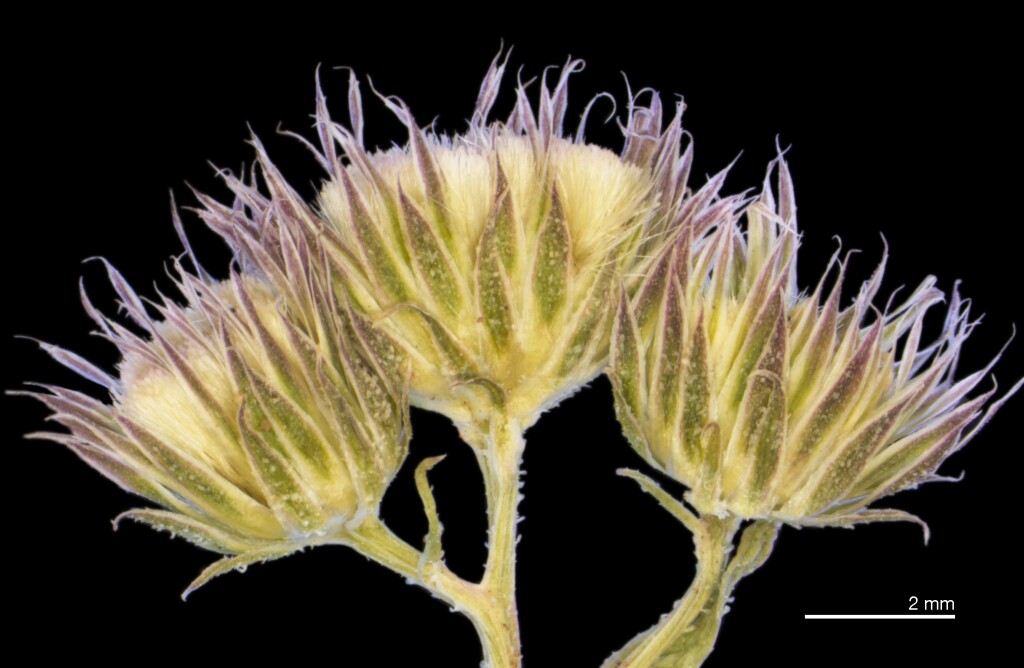Pluchea rubelliflora
(F.Muell.) B.L.Rob. Winged Plains-bushPerennial herb or subshrub to 15–60 cm high. Stems ascending to erect, ± terete, usually conspicuously narrowly winged from decurrent leaf bases, glabrous or glabrescent. Leaves narrowly lanceolate to oblanceolate to broadly oblanceolate, 9–50 mm long, 2–7 mm wide, 4.5–12 times longer than broad, margins entire or denticulate to dentate, apex acute, glabrous or glabrescent. Capitula solitary to several in terminal clusters, hemispherical, 4–5 mm long, peduncle 1–12 mm long; outer involucral bracts 1.3–1.8(–2.6) mm long, lanceolate, apex acute to acuminate, glabrous to sparsely glandular or with a mixture of glandular and eglandular hairs, margin scarious; inner involucral bracts (2.8–)3.0–4.2(–4.5) mm long, lanceolate, linear, apex acute. Outer florets (i.e. female) numerous, 2.0–2.5(–3.5) mm long, corolla tube filiform, white or pink-tinged; style white; achenes 0.6–0.8 mm long, glabrous, red-brown; pappus bristles 10–13, 1.8–2.5 mm long. Disc florets 5–30, 2.0-3.0(–4.0) mm long, corolla tube cylindrical; style mauve; achenes pale, abortive. Flowers Apr. (1 Victorian collection), but outside Victoria flowers and fruits (Apr.–)May–Nov.
MuM, RobP. Also WA, NT, SA, Qld, NSW. Widespread in lower rainfall areas of Australia, mainly in the tropics and subtropics, but extending almost to Port Augusta in South Australia. Outside Victoria it often inhabits dry watercourses, low-lying areas, clay-pans, and often occurs on salt-affected land including areas near salt lakes, and sites adjacent to coastal mangroves. The sole Victorian record is from Lake Yelwell in Hattah-Kulkyne National Park, where growing on a dry floodplain, near the lake shore.
The Victorian occurence of Pluchea rubelliflora was discovered in 2018, and represents a significant disjunction from the nearest other known population north of Broken Hill in New South Wales. Whilst an adventive origin is conceivable for such a disjunct occurrence, consistency of habitat with that of indigenous occurrences elsewhere suggests that the Victorian occurrence is also indigenous.
Pluchea rubelliflora is distinguished from other Australian Pluchea species by the glabrous or glabrescent stems and leaves, relatively small capitula and decurrent leaves (Bean 2015).
 Spinning
SpinningBean, A.R. (2015). Pluchea. In: Wilson, A., Flora of Australia Volume 37, Asteraceae 1, pp. 408–417. ABRS/CSIRO Publishing, Canberra/Melbourne.
Hunger, S. (1997). A survey of the genus Pluchea (Compositae, Plucheeae) in Australia. Willdenowia 27: 207–223.
Moxham, C.; Stajsic, V.; Kenny, S.A.; Bennetts, K.; Sutter, G.; Sluiter, I.; Cameron, D. (2019). Pluchea rubelliflora and Pterocaulon sphacelatum (Asteraceae): new to Victoria’s semi-arid floodplains. Muelleria 37: 119–126.




